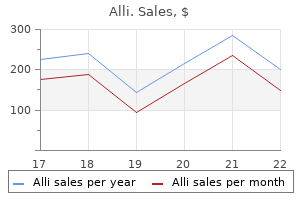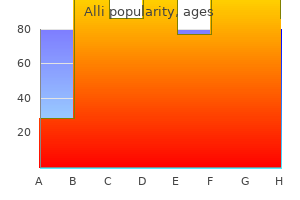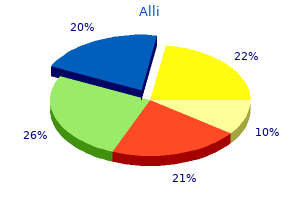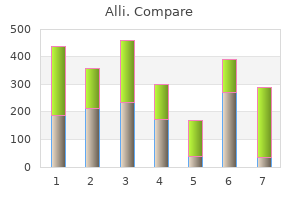





|
STUDENT DIGITAL NEWSLETTER ALAGAPPA INSTITUTIONS |

|
"Alli 60 mg with amex, weight loss pills lycopene".
W. Kaffu, M.A., Ph.D.
Medical Instructor, Sanford School of Medicine of the University of South Dakota
High-dose steroids weight loss while breastfeeding purchase 60 mg alli overnight delivery, colchicine weight loss pills nyc cheap alli 60mg, and androgens have been tried with mild-to-moderate success weight loss ky discount alli 60 mg without a prescription. Several other features observed include respiratory distress weight loss 757 alli 60mg without a prescription, aphthous ulcers, hepatomegaly, and failure to thrive. Anakinra treatment results in a rapid and sustained response, with correction of laboratory abnormalities, resolution of rash, and healing of bone lesions in all but 1 affected patient. Blau syndrome should be suspected in patients presenting with noncaseating granulomas in the skin, eyes, and joints. Joint involvement in patients with Blau syndrome presents with a boggy synovitis and tenosynovitis, with cystic swelling of the large joints, particularly the wrists and ankles. The rash seen in patients with Blau syndrome is described as erythematous maculopapular, lichenoid papules, or similar to erythema nodosum. Less frequent involvement includes granulomatous liver disease, cranial neuropathies, large-vessel vasculitis, and interstitial lung disease. Unlike sarcoidosis, respiratory involvement is rare in patients with Blau syndrome. Results of laboratory studies in patients with Blau syndrome are typically normal. Antinuclear antibodies are either negative or of low titer, and rheumatoid factor is typically negative. Corticosteroids should be the mainstay of treatment for patients with Blau syndrome. The age of onset varied greatly in patients with this disorder, from several weeks of life to young adulthood. The patients with episodes with infections after pregnancy were given a diagnosis of impetigo herpetiformis, an uncommon complication of pregnancy. It was also not reported whether affected patients exhibited laboratory evidence of autoimmunity. Mediterranean and Middle Eastern populations have a higher carrier frequency of different mutations, suggesting a heterozygous advantage for pathogens endemic to this region. The mechanism that invokes an attack is not well understood, although reported triggers include stress and menstruation. Abdominal symptoms include distention, rigidity, and severe pain, which can mimic acute appendicitis. Joint symptoms, including arthralgia and arthritis, are common and can be a presenting sign in children. Synovial aspirates from joint effusions are sterile, with a predominance of neutrophils (>100,000/ mm3). Classically, an erysipeloid erythematous rash can occur on the lower legs as an isolated sign or in conjunction with other manifestations. Abdominal pain and diarrhea are the most common side effects, and gradually increasing the dose can help this. For more severe disease, etanercept reduces symptoms of inflammation in a dose-dependent manner, but failure of sustained efficacy and lack of normalization of acute-phase reactants has been reported. At an early age, patients present with recurrent fever spikes lasting 4 to 6 days accompanied by lymphadenopathy, abdominal pain, diarrhea, vomiting, arthralgia, rash, aphthous ulcers, and splenomegaly. Patients with mevalonic aciduria have nondetectable enzyme activity and severe symptomatology, including psychomotor retardation, facial dysmorphism, and failure to thrive. Clinical criteria to warrant genetic tests include earlyonset disease, lymphadenopathy, skin rash, transient joint pain, and white ethnic background. By the time of puberty, debilitating ulcerative skin lesions similar to pyoderma gangrenosum develop, often on the lower extremities, and cystic acne occurs, which persists into adulthood. These disorders should be suspected in patients with early-onset fevers, systemic inflammation, and purpuric plaques caused by cutaneous leukocytoclastic vasculitis. The disorder has several eponyms, including NakajoNishimura syndrome, Japanese autoinflammatory syndrome with lipodystrophy,695 joint contractures, muscle atrophy, panniculitis-induced lipodystrophy syndrome,696,697 and chronic atypical neutrophilic dermatitis with lipodystrophy and increased temperatures. More effective targeted therapy, such as interferon signaling blockade, is worthy of investigation. Chronic recurrent multifocal osteomyelitis dyserythropoietic anemia (or Majeed) syndrome.

Partial T and B lymphocyte immunodeficiency and predisposition to lymphoma in patients with hypomorphic mutations in Artemis weight loss visualization purchase 60mg alli with amex. Cernunnos weight loss pills homemade purchase 60mg alli with mastercard, a novel nonhomologous end-joining factor weight loss 9 year old buy alli 60mg with visa, is mutated in human immunodeficiency with microcephaly weight loss pills bad for you discount 60mg alli free shipping. Cernunnos influences human immunoglobulin class switch recombination and may be associated with B cell lymphomagenesis. Novel mutations and diverse clinical phenotypes in recombinase-activating gene 1 deficiency. Recombinase-activating gene 1 immunodeficiency: different immunological phenotypes in three siblings. Early defects in human T-cell development severely affect distribution and maturation of thymic stromal cells: possible implications for the pathophysiology of Omenn syndrome. Clinical and immunologic consequences of a somatic reversion in a patient with Xlinked severe combined immunodeficiency. Felgentreff K, Perez-Becker R, Speckmann C, Schwarz K, Kalwak K, Markelj G, et al. Clinical and immunological manifestations of patients with atypical severe combined immunodeficiency. Human syndromes of immunodeficiency and dysregulation are characterized by distinct defects in T-cell receptor repertoire development. Optimizing outcomes of hematopoietic stem cell transplantation for severe combined immunodeficiency. Respiratory syncytial virus infection in patients with hematological diseases: single-center study and review of the literature. Hematopoietic stem cell gene therapy for adenosine deaminase-deficient severe combined immunodeficiency leads to long-term immunological recovery and metabolic correction. Hematopoietic stem-cell transplantation for the treatment of severe combined immunodeficiency. High-definition mapping of retroviral integration sites identifies active regulatory elements in human multipotent hematopoietic progenitors. Congenital pancytopenia and absence of B lymphocytes in a neonate with a mutation in the Ikaros gene. Purine nucleoside phosphorylase deficiency presenting as severe combined immune deficiency. Pachlopnik Schmid J, Lemoine R, Nehme N, Cormier-Daire V, Revy P, Debeurme F, et al. Reversible severe combined immunodeficiency phenotype secondary to a mutation of the proton-coupled folate transporter. Granulocyte colony-stimulating factor: key (f)actor or innocent bystander in the development of secondary myeloid malignancy? Martinez Ibanez V, Espanol T, Matamoros N, Iglesias J, Allende H, Lucaya T, et al. Relapse of sclerosing cholangitis after liver transplant in patients with hyper-Ig M syndrome. Advances in our understanding of the molecular basis of disorders of platelet function. Wiskott-Aldrich syndrome: diagnosis, clinical and laboratory manifestations, and treatment. Long-term outcome following hematopoietic stem-cell transplantation in Wiskott-Aldrich syndrome: collaborative study of the European Society for Immunodeficiencies and European Group for Blood and Marrow Transplantation. Long-term outcome and lineage-specific chimerism in 194 patients with Wiskott-Aldrich syndrome treated by hematopoietic cell transplantation in the period 1980-2009: an international collaborative study. The cellular ataxia telangiectasia-mutated kinase promotes Epstein-Barr virus lytic reactivation in response to multiple different types of lytic reactivation-inducing stimuli. Autopsy study of cerebellar degeneration in siblings with ataxia-telangiectasia-like disorder. Hematopoietic stem cell transplantation corrects the immunologic abnormalities associated with immunodeficiency-centromeric instability-facial dysmorphism syndrome.
Indirect ophthalmoscopy can also be used to semi-qualify the refractive error of an animal by slowly withdrawing the lens toward the examiner and further from the eye and observing any change in magnification weight loss before and after tumblr purchase alli 60mg on-line. The fundic image may get smaller which indicates that the animal is somewhat hyperopic or larger weight loss pills kardashians discount alli 60mg with amex, indicating that the animal is somewhat myopic; or it may remain static indicating that the animal is emmetropic weight loss 5 lbs per week 60 mg alli free shipping. Disadvantages include an inverted and reversed image (upside down and backward) and less magnification (Gilger and Stoppini 2011; Featherstone and Heinrich 2013) (Fig 13c) weight loss 800 calories per day purchase alli 60 mg without a prescription. Direct and indirect ophthalmoscopy complement each other, particularly if a lesion is detected with indirect ophthalmoscopy and closer examination is then performed with direct method (Murphy and Howland 1987). High quality images have been captured using a smartphone and 20D lens in man and rabbits. By using the coaxial light source of the phone, this system works as an indirect ophthalmoscope that creates a digital image of the fundus (Haddock 2013). A smartphone adaptor has also been developed as an attachment for the PanOptic1 enabling acquisition of images of the ocular fundus. Additional diagnostic tests Corneal culture Bacteria and fungal culture and sensitivity should be considered in all cases of corneal ulceration. Culture can be performed with a swab or a scraping, using either a sterile surgical blade or a Kimura spatula. The eyelids should be retracted to avoid contamination from palpebral conjunctiva and the samples taken from the edges of a corneal ulcer to avoid possible further damage. Specimens for culture should be obtained before the administration of topical agents because many topical ophthalmic preparations contain preservatives that may interfere with culture results. However, it has been shown that a single application of proxymetacaine/proparacaine is unlikely to affect culture results (Champagne and Pickett 1995). If the horse is so painful that even with sedation and regional nerve blocks does not allow obtaining a sample, a single application of topical anaesthesia can be applied. Panoptic ophthalmoscopy A panoptic ophthalmoscope (PanOptic)1 is a monocular indirect ophthalmoscope (Fig 16) that gives a real image and intermediate magnification between direct and indirect magnification (Fig 13b). Fundus photography Recording of ocular and fundic images facilitates monitoring of disease progression and response to treatment. While high quality images of the anterior segment and ocular adnexa may be acquired with common digital cameras, acquisition of fundic images requires specialised fundus cameras. If such a camera is not available, acquisition of images may be performed using a smartphone. With a camera application that allows the adjacent light to be turned on permanently the smartphone can be used in a similar fashion to a direct ophthalmoscope to obtain an image of the fundus. Unlike culture and sensitivity, cytology can provide rapid results that may guide the immediate course of therapy. Cytology is indicated in all cases of ulcerative keratitis in the horse (Gilger and Stoppini 2011). Under topical anaesthesia, a cytrobrush, the black/ blunt end of a scalpel blade or Kimura spatula can be used to gently scrape the cornea at the affected area. In the case of deep or melting corneal ulceration in which excessive manipulation may be contraindicated, cottontipped swabs are the least traumatic method to obtain a sample. Cell preservation using a cytobrush is superior when compared with a cotton-wool tip and spatulas (Bauer et al. Diff-Quik, Wright-Giemsa stain) and/or a Gram stain to identify bacteria (cocci or rods), fungal hyphae and yeasts and characterise the type of inflammatory process. Ophthalmic dyes (sodium fluorescein, Rose bengal) Ophthalmic dyes are frequently used in veterinary ophthalmology to determine the health and integrity of the corneal and conjunctival epithelium and the physiological flow of the nasolacrimal system. The two most commonly used in clinical veterinary ophthalmology are sodium fluorescein and Rose bengal. It also stains corneal fibrovascular (granulation) tissue and conjunctival ulcerations and abrasions. Nonsterile prepared solutions should be avoided because they have been associated with bacterial contamination (Cello and Lasmanis 1958). The easiest method to perform the fluorescein test in horses is to place the sterile strip inside a 3 ml syringe and fill it with sterile saline solution or eyewash. The solution is then gently flushed onto the cornea and the animal allowed to blink or the eyelids should be closed after application to distribute the stain across the ocular surface.

Because of the relationship of the drug to other tricyclic compounds weight loss kale smoothies order alli 60 mg fast delivery, the possibility of activation of a latent psychosis and weight loss pills ky discount 60 mg alli with visa, in elderly patients weight loss naturally generic alli 60mg fast delivery, of confusion or agitation should be borne in mind weight loss pills 2013 uk buy alli 60 mg on-line. The use of Tegretol should be avoided in patients with a history of hepatic porphyria. Carbamazepine administration has also been demonstrated to increase porphyrin precursors in rodents, a presumed mechanism for the induction of acute attacks of porphyria. As with all antiepileptic drugs, Tegretol should be withdrawn gradually to minimize the potential of increased seizure frequency. Usage in Pregnancy Carbamazepine can cause fetal harm when administered to a pregnant woman. Epidemiological data suggest that there may be an association between the use of carbamazepine during pregnancy and congenital malformations, including spina bifida. There have also been reports that associate carbamazepine with developmental disorders and congenital anomalies. In treating or counseling women of childbearing potential, the prescribing physician will wish to weigh the benefits of therapy against the risks. If this drug is used during pregnancy, or if the patient becomes pregnant while taking this drug, the patient should be apprised of the potential hazard to the fetus. Retrospective case reviews suggest that, compared with monotherapy, there may be a higher prevalence of teratogenic effects associated with the use of anticonvulsants in combination therapy. Therefore, if therapy is to be continued, monotherapy may be preferable for pregnant women. In humans, transplacental passage of carbamazepine is rapid (30-60 minutes), and the drug is accumulated in the fetal tissues, with higher levels found in liver and kidney than in brain and lung. In rat teratology studies, 2 of 135 offspring showed kinked ribs at 250 mg/kg and 4 of 119 offspring at 650 mg/kg showed other anomalies (cleft palate, 1; talipes, 1; anophthalmos, 2). In reproduction studies in rats, nursing offspring demonstrated a lack of weight gain and an unkempt appearance at a maternal dosage level of 200 mg/kg. Antiepileptic drugs should not be discontinued abruptly in patients in whom the drug is administered to prevent major seizures because of the strong possibility of precipitating status epilepticus with attendant hypoxia and threat to life. In individual cases where the severity and frequency of the seizure disorder are such that removal of medication does not pose a serious threat to the patient, discontinuation of the drug may be considered prior to and during pregnancy, although it cannot be said with any confidence that even minor seizures do not pose some hazard to the developing embryo or fetus. Tests to detect defects using currently accepted procedures should be considered a part of routine prenatal care in childbearing women receiving carbamazepine. There have been a few cases of neonatal seizures and/or respiratory depression associated with maternal Tegretol and other concomitant anticonvulsant drug use. A few cases of neonatal vomiting, diarrhea, and/or decreased feeding have also been reported in association with maternal Tegretol use. This can be done by calling the toll free number 1-888-233-2334, and must be done by patients themselves. Discontinuation of carbamazepine should be considered if any evidence of hypersensitivity develops. Hypersensitivity reactions to carbamazepine have been reported in patients who previously experienced this reaction to anticonvulsants including phenytoin and phenobarbital. A history of hypersensitivity reactions should be obtained for a patient and the immediate family members. Information for Patients Patients should be made aware of the early toxic signs and symptoms of a potential hematologic problem, as well as dermatologic, hypersensitivity or hepatic reactions. These symptoms may include, but are not limited to , fever, sore throat, rash, ulcers in the mouth, easy bruising, lymphadenopathy and petechial or purpuric hemorrhage, and in the case of liver reactions, anorexia, nausea/vomiting, or jaundice. The patient should be advised that, because these signs and symptoms may signal a serious reaction, that they must report any occurrence immediately to a physician. In addition, the patient should be advised that these signs and symptoms should be reported even if mild or when occurring after extended use. Behaviors of concern should be reported immediately to healthcare providers Tegretol may interact with some drugs. Therefore, patients should be advised to report to their doctors the use of any other prescription or nonprescription medications or herbal products. Caution should be exercised if alcohol is taken in combination with Tegretol therapy, due to a possible additive sedative effect. Since dizziness and drowsiness may occur, patients should be cautioned about the hazards of operating machinery or automobiles or engaging in other potentially dangerous tasks. This registry is collecting information about the safety of antiepileptic drugs during pregnancy.

A need exists for more sickle cell screenings weight loss groups order 60mg alli with mastercard, education weight loss icd 10 generic alli 60mg with amex, and counseling among university students weight loss pills purchase alli 60mg on-line. In a similar study weight loss pills in stores cheap alli 60mg otc, Stewart and colleagues conducted a mixed-method study using a sample of 191 African-American college students from the Southeast who ranged from 19 to 30 years of age (Prabhakar, 2009). The investigators found a lack of knowledge regarding carrier status, family history, and genetic testing among the target group (Prabhakar, 2009). Results 30 showed that participants poorly understood questions related to patterns of inheritance. Both scores were believed to be "strikingly" similar by the researcher (Dyson, 1997). Three carrier participants claimed to receive counseling, but no significant differences occurred between those counseled and those not counseled. Researchers believed this discrepancy to be a result of incomplete or inaccurate addresses, as well as several methodological oversights. Without awareness and a public outcry for a cure and more funding, sickle cell disease will continue to be a silent killer to young men and women around the world. The exclusion criteria for this study included any person not enrolled in the Community Health courses 210, 250, and 260, unwillingness to participate, and students under the age of 18. Two hundred fifty-nine (259) questionnaires were distributed among the three classes. Participants were not placed in physical, emotional, or academic harm at any time during the course of the study. Before the questionnaires were distributed, a consent form was read and distributed to all students for their review (see Appendix D). The consent form informed participants that the research study was voluntary and that they would not be placed at any risk following the completion of the 33 study. After the consent form was read and distributed, students had approximately 10 to 15 minutes to complete their questionnaire in class under the supervision of their professor. To maintain the confidentiality of all participants, names and signatures were not retrieved on the questionnaires. Members of the research team collected the questionnaires to protect the anonymity of participants. Two faculty members of the Community Health Department reviewed the questionnaire. The questionnaire contained four categories of race identification for participants to identify: 1) Caucasian, 2) African-American, 3) Hispanic, and 4) Other. Frequency tables were divided by ethnicity and response results, whereas cross-tabulation tables grouped all response variables together by ethnicity per result question. Although 259 participants were included in the analysis, not all participants responded to each question. Percentages reported in this study are analyzed results from the total number of participants who responded to each question. Those questions left unanswered were coded as (0) and did not conflict with the overall analysis and study. Of the 259 participants who responded to the questionnaire, approximately 54% of the respondents identified themselves as Caucasian, 22% identified themselves as being AfricanAmerican, 0. Eighty-one percent of the participants knew that sickle cell disease evolved from Africa. On the other hand, only 17% of the participants were able to identify the number of new births born with sickle cell disease. The number of correct responses decreased when students were asked 37 specific questions regarding the incidence and prevalence rate of sickle cell disease, as shown in Table 11. Both genders had a general understanding of sickle cell disease from a medical standpoint. A significant difference occurred in knowledge between males and females when compared to previously discussed questions. The percentages of Caucasian students who correctly identified the medical complications caused by sickle cell disease were 85. This study showed that no statistical difference existed in the variation of response rates between ethnicities. Research Question 1 asked, "How knowledgeable are midwestern college students on background information regarding sickle cell disease?
